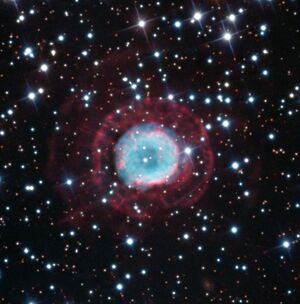Astronomy:NGC 2438
| Emission nebula | |
|---|---|
| Planetary nebula | |
 | |
| Observation data: J2000.0 epoch | |
| Right ascension | 07h 41m 50.51986s[1] |
| Declination | −14° 44′ 07.4843″[1] |
| Distance | 1,370 ± 130 ly (420 ± 40 pc)[1] ly |
| Apparent magnitude (V) | +10.8 |
| Apparent dimensions (V) | 1.1 arcmins |
| Constellation | Puppis |
| Notable features | Superimposed on Messier 46 |
NGC 2438 is a planetary nebula in the southern constellation of Puppis.[2] Parallax measurements by Gaia put the central star at a distance of roughly 1,370 light years.[1] It was discovered by William Herschel on March 19, 1786.[3] NGC 2438 appears to lie within the cluster M46, but it is most likely unrelated since it does not share the cluster's radial velocity.[4][5] The case is yet another example of a superposed pair, joining the famed case of NGC 2818.[4][6]
This is a multi-shell planetary nebula with a bright inner nebula with a diameter of 60″, consisting of two somewhat detached shells.[7] It is expanding with a velocity of 37 km/s.[8] The structure is surrounded by a fainter, mostly circular halo that is more visible on the western half,[7] and has a diameter of 130″.[8] The mass of the main nebula is estimated at 0.45 M☉, while the shell has 0.5–0.8 M☉.[7] The main nebula has a temperature of about 10–13,000 K, rising to 15–17,000 K at the inner edge.[9]
The nebula consists of material ejected from the central star during the asymptotic giant branch stage, beginning some 8,500 years ago. The main nebula was formed at about half that age.[8] The central star of this planetary nebula is a 17.7-magnitude white dwarf,[3] with surface temperature of about 75,000 K (74,700 °C).[10] It is one of the hottest stars known.
Gallery
HaRGB image of the planetary nebula NGC 2348, from the Liverpool Telescope
References
- ↑ Jump up to: 1.0 1.1 1.2 1.3 Brown, A. G. A. (August 2018). "Gaia Data Release 2: Summary of the contents and survey properties". Astronomy & Astrophysics 616: A1. doi:10.1051/0004-6361/201833051. Bibcode: 2018A&A...616A...1G. Gaia DR2 record for this source at VizieR.
- ↑ Nemiroff, R.; Bonnell, J., eds (2011-04-07). "Planetary Nebula NGC 2438". Astronomy Picture of the Day. NASA. https://apod.nasa.gov/apod/ap110407.html.
- ↑ Jump up to: 3.0 3.1 "NGC Objects: NGC 2400 - 2449". http://cseligman.com/text/atlas/ngc24.htm#2438.
- ↑ Jump up to: 4.0 4.1 Majaess, D. J. et al. (2007). "In Search of Possible Associations between Planetary Nebulae and Open Clusters". Publications of the Astronomical Society of the Pacific 119 (8): 1349. doi:10.1086/524414. Bibcode: 2007PASP..119.1349M.
- ↑ Kiss, L. L. et al. (November 2008). "AAOmega radial velocities rule out current membership of the planetary nebula NGC 2438 in the open cluster M46". Monthly Notices of the Royal Astronomical Society 391 (1): 399–404. doi:10.1111/j.1365-2966.2008.13899.x. Bibcode: 2008MNRAS.391..399K.
- ↑ Mermilliod, J.-C. et al. (August 2001). "Red giants in open clusters. IX. NGC 2324, 2818, 3960 and 6259". Astronomy and Astrophysics 375: 30–39. doi:10.1051/0004-6361:20010845. Bibcode: 2001A&A...375...30M.
- ↑ Jump up to: 7.0 7.1 7.2 Öttl, S. et al. (May 2014). "Ionization structure of multiple-shell planetary nebulae. I. NGC 2438". Astronomy & Astrophysics 565: 13. doi:10.1051/0004-6361/201323205. A87. Bibcode: 2014A&A...565A..87O.
- ↑ Jump up to: 8.0 8.1 8.2 Corradi, R. L. M. et al. (February 2000). Manchado, A.; Stanghellini, L.; Schoenberner, D.. eds. "A hydrodynamical study of multiple-shell planetaries . I. NGC 2438". Astronomy and Astrophysics 354: 1071–1085. Bibcode: 2000A&A...354.1071C.
- ↑ Dalnodar, Silvia (August 2012). "The ionization state of the halo planetary nebula NGC 2438". Planetary Nebulae: An Eye to the Future, Proceedings of the International Astronomical Union, IAU Symposium. 283. pp. 338–339. doi:10.1017/S1743921312011313. Bibcode: 2012IAUS..283..338D.
- ↑ "Planetary Nebula NGC 2438 in Puppis". March 13, 2000. http://www.kopernik.org/images/archive/n2438.htm.
External links
Coordinates: ![]() 07h 41m 50.6s, −14° 44′ 05″
07h 41m 50.6s, −14° 44′ 05″
 |


